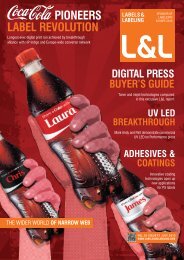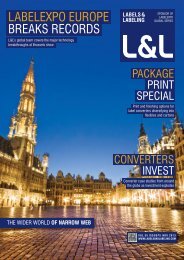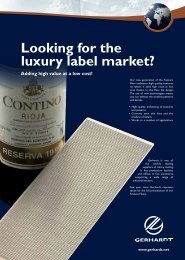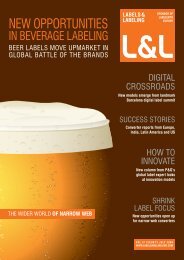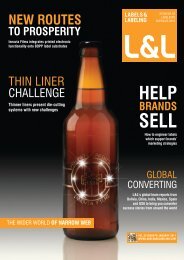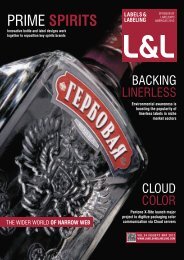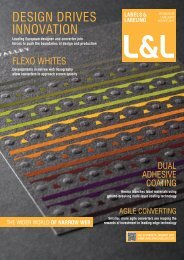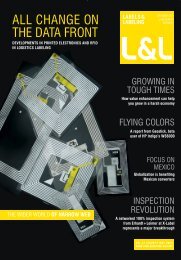Create successful ePaper yourself
Turn your PDF publications into a flip-book with our unique Google optimized e-Paper software.
LABELS&LABELING |41<br />
Hammer looks<br />
to G7 future<br />
G7 CERTIFICATION FOR THE PACKAGING INDUSTRY is the ticket for a brand’s print buyer to ensure<br />
consistency across variables and offers other benefits, writes Danielle Jerschefske<br />
Hammer Packaging in Rochester, New York, is one of the<br />
first packaging printers in North America to achieve G7<br />
Master Printer Status, a qualification granted by IDEAlliance,<br />
a non-profit industry association which disseminates best<br />
practice methodologies, specifications and standards for the<br />
print industry.<br />
When it comes to print consistency across a brand-marketing<br />
portfolio, print buyers have traditionally found it difficult<br />
to match color across different regions or across different<br />
print types and materials. For the packaging industry, G7<br />
represents a radically different approach to this problem.<br />
Because Hammer produces printed labels and package<br />
decorations for the global beverage, food, horticulture<br />
and household products industries, including cut & stack,<br />
in-mold, shrink sleeve, roll-fed and pressure sensitive<br />
labels, it was eager to reap the benefits found in the G7<br />
methodology.<br />
Essentially G7, or Near-Neutral Calibration, defines targets<br />
that allow packaging printers to match a proof to a press; a<br />
press to a press; one process to another; and across various<br />
consumables. The ‘G’ stands for gray as in gray balance<br />
or neutrality, and the ‘7’ refers to the seven major process<br />
printing colors.<br />
G7 uses colorimetry to specify both the color of the media,<br />
in white point, and the color of the inks in accordance with<br />
ISO 12647-2, which describes gray balance as 50/40/40<br />
CMY. The resulting grayscale and tonal curve is used for<br />
calibrating a proofing and/or printing system. G7 utilizes the<br />
new ISO 10128 standard to set near-neutral calibration.<br />
Rather than changing the tint by diluting color with white<br />
or black ink, a grayscale-based system adjusts the tone,<br />
where the eye is more sensitive than saturated color. All a G7<br />
certified converter like Hammer has to do is maintain gray<br />
balance and tone within this set range.<br />
BENEFITS TO BRAND AND CONVERTER<br />
Lou Iovoli, Hammer’s VP strategic partnerships and<br />
marketing, says, ‘The advantage to the brand owner is that<br />
we can provide our press 'condition' to a given designer so<br />
they can provide customers with a proof that will match the<br />
final print image from our press. In this way our customers<br />
will know sooner what a design will look like, rather than<br />
having to wait or travel for a press approval.’<br />
Hammer started using the G7 process to control both<br />
press and proofing in Fall 2010. Iovoli says, 'With this<br />
process we are able to map the wide gamut of colors used<br />
in packaging and produce a proof that represents the press<br />
condition. This process takes into consideration the various<br />
combinations of substrate and inking in either surface or<br />
reverse printing. We strive to reduce the uncertainty of the<br />
proof matching the printed sample, allowing us to deliver<br />
high quality products for our customers.'<br />
A second benefit is that the print file no longer needs to<br />
be modified or adjusted to print to any of Hammer's presses<br />
regardless of the printing process or consumables used. This<br />
can mean significant cost savings since one file can be used<br />
for everything: cartons, labels, a webpage, POP and flexible<br />
packaging.<br />
If all the print products have the same gray balance and neutral<br />
tonality defined by G7, they will all look remarkably alike to the<br />
human eye. Since buyers believe the similarity of the visual<br />
appearance across print products is critical, and are gaining a<br />
better understanding of the G7 method, many have started to<br />
make G7 a buying requirement.<br />
Lastly, G7 calibration gives print buyers flexibility in processes<br />
and materials used in the packaging industry. It streamlines the<br />
coordination between the pre-press house and printer thereby<br />
improving speed to market.<br />
THE STEPS<br />
G7 defines the print condition in two ways – tone reproduction,<br />
gray scale – and it describes how to use the principles of digital<br />
imaging, spectrophotometry, and computer-to-plate (CtP)<br />
technologies to achieve color matches using quality inks and<br />
papers. Its Neutral Print Density Curve (NPDC) defines the<br />
neutral density of the grayscale curve with a combined CMY<br />
curve of 50/40/40 at the middle tone and specifies the tone from<br />
highlight to shadow, taking priority over traditional TVI curves. The<br />
calibration method calculates corrected RIP values that will force<br />
the press to replicate the desired NPDC curve based on the given<br />
press conditions.<br />
As the NPDC curve approaches the solids then the lines will<br />
deviate. Gray process control patches should always be printed on<br />
the production runs in order to regularly verify gray balance. It is<br />
important to remember that gray balance tells the printer that the<br />
JULY 2012 | L&L



